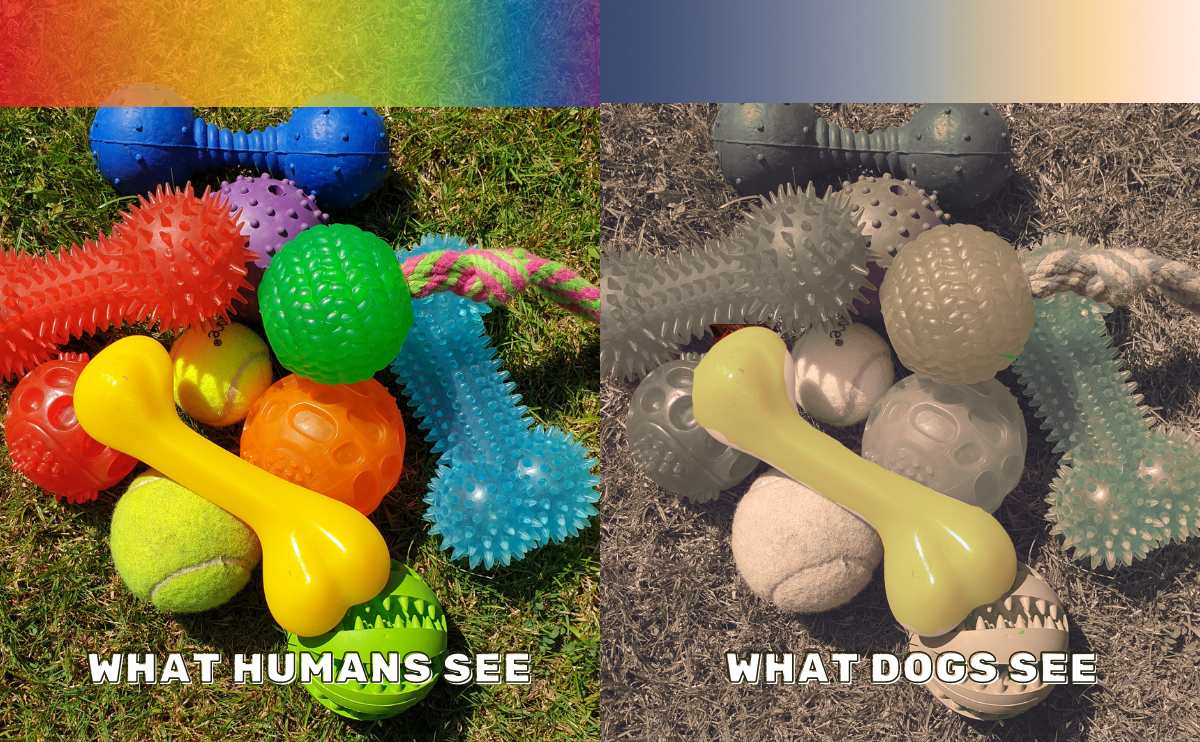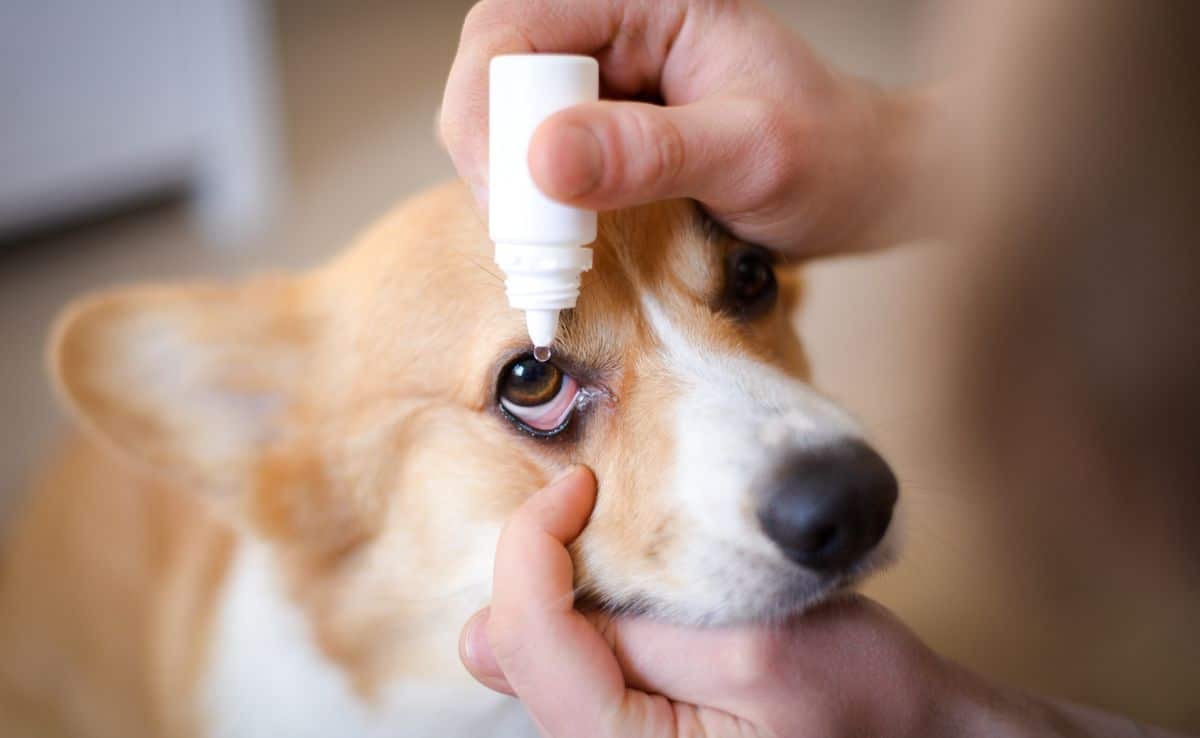Can Dogs See Color? Are Dogs Color Blind?
When you purchase through links on our site, we may earn a commission. Here’s how it works.

You may have heard that dogs only see the world in black, white, and shades of gray. This was the accepted belief for years. But that thinking is in the past. Research has shed some fascinating light on how dogs see color and how their color vision differs from humans. While dogs can see color, they cannot see all of them the same way humans can.
Table of Contents
Dog owners like me have many questions about whether dogs are color blind and what precisely the visible dog color spectrum is. There is more than a simple yes or no when answering the question, “Can dogs see color?”
Can Dogs See Color?
Yes, dogs can see color, but not in the same way as people do. Research has found that dogs don’t see as many colors as humans, and they don’t see colors as brightly as we do. How do dogs see the world? Unfortunately, it’s not nearly as vibrant as we see it, but dogs certainly don’t live in a black-and-white world.
Are Dogs Color Blind?
Dogs do have a form of color blindness, or reduced color perception, just as some humans are color blind. Dogs’ color vision is most similar to humans who are red-green color blind. Are all dogs color-blind? Yes, unlike humans, all dogs have a form of color blindness. This does not mean they don’t have any color perception. Dogs can see some color, just not in the same way humans do.
Researchers are always looking to learn more about canine color perception. Italian scientific researchers from the University of Bari looked at the subject, and their study concluded that dogs see color in a similar way to humans with red-green color blindness.
How Do Dogs See Color?

You might be wondering, how do dogs see? And how do scientists know that dogs are color blind? It comes down to the structure of dogs’ eyes. The eye’s nerve cells (in humans and animals) are responsible for detecting colors. The retina has two primary types of nerve cells — cones, which detect and differentiate colors, and rods, which detect motion and light levels. Dogs only have two types of cones (dichromatic), whereas humans have three (trichromatic). Therefore, dogs can’t detect as many colors as people do. The cones in their eyes can only detect blue and yellow shades.
Human eyes have more cones than dog eyes, but canines have more rods in the retina than humans. The higher number of rods in dog’s eyes helps them see better in low light than we can. More rods in the retina also help dogs detect moving objects better than stationary ones. This is why they often pick up movement in the distance that the human eye cannot easily detect.
What Colors Do Dogs See?
The dog color spectrum is limited compared to ours. While people see colors in ranging shades of blue, yellow, green, violet, red, orange, etc., dogs can only see blue, yellow, gray, and brown shades. The colors dogs do perceive are less vibrant than what we see.
Can Dogs See Blue?
Yes, dogs can see blue. Blue is one of the two dominant colors in a dog’s vision. Researchers believe that dogs can only distinguish purple and violet as blue. Blue is the most prevalent color that dogs see.
Can Dogs See Yellow?
Yes, in addition to blue, yellow is the other dominant color that dogs can see. You may notice your pup drawn to brightly colored yellow balls and toys.
Can Dogs See Red?
No, dogs can’t see red. So, a red toy, for example, likely appears as gray-brownish or even black. The same is true for orange.
Can Dogs See Green?
You might think that dogs can see green because they can see blue and yellow, but, in fact, dogs cannot see green. Green appears to dogs as gray-brownish or blue.
Does Toy Color Make A Difference?
Because blue is the color that dogs see best, picking a blue toy, especially when playing outside, gives them a higher chance of seeing it clearly. Blue is a top pick when selecting a new fetch ball, herding ball, or frisbee, as it will stand out against the background more vibrantly.
Toys for the inside come in many colors. Blues, yellows, and purples are easier for dogs to see in general. This does not mean they will not enjoy toys of other colors. The color of the toy is less important than playing and interacting with owners.
Check out this video about dog vision and why you might want to choose blue or yellow-colored toys over others. See our picks for the best dog toys.
How Else Does Dog Vision Differ From Humans?
Dogs have more rod cells in their retina than humans. Since rod cells are responsible for detecting light and motion, dogs can see much better in lower light conditions. Their eyes can detect motion much better than humans, especially at longer distances. This is thought to be a survival adaptation so that dogs can hunt and protect themselves in the wild more than humans need to do. Also, dogs can see better in the dark than we can.
Due to the different physical structures, canine eyes are more sensitive to light and motion than colors. This also gives them better night vision. Dogs do not see in the dark in the way we see through night vision goggles, but they can detect shapes and motions in low light much better than humans. Due to fewer cones in their eyes, dogs have less detailed sight.
Canine eyes have a different physical structure than humans. This includes something called the reflective tapetum lucidum that the human eye does not have. It is a membranous layer of tissue that works as a biological reflector system. The tapetum bounces more light into the retina, which allows more light in. Dogs also have larger pupils, which means more light enters the eye.
Along with a different eye structure, dogs also have different eye placement than humans, which impacts how well and what they can see. Dog’s eyes are located on the sides of their heads, rather than the front, like us. This gives canines a larger field of vision, about 240 to 250 degrees versus our 200 degrees. Dogs with narrower faces and longer snouts, like the Borzoi or Border Collie, have better vision than brachycephalic breeds like French Bulldogs, Boxers, Pekingese, Pugs, and other flat-faced pups.
Can Dogs See TV?
Yes, dogs can see TV screens, similar to humans. Many, including some Canine Journal dogs, seem to enjoy the visuals and sounds of watching television.
However, dogs perceive images and sound from television differently than humans since they rely heavily on their senses of smell and hearing more than visual stimuli. While dogs can recognize familiar objects or people on the screen, it is unknown whether they fully comprehend that it is not real or present in their physical environment.
Our Personal Experience

When a dog comes on the TV, my dog Georgie tries to jump through the screen or run on the other side of it thinking the dog is behind the television. Georgie also loves to watch Golf and gets noticeably calmer while watching it.
– Sadie Cornelius, Dog Mom to Cavalier King Charles Spaniel
Do Dogs Need Glasses?
Some research has shown that many dogs are naturally nearsighted and may benefit from glasses. But even if you don’t think your dog needs glasses to see better, some products can help protect your dog’s eyes from the elements. See our article about dog goggles and protective eyewear to learn more.
Owners must work to keep their dog’s eyes and vision healthy. Dogs can develop various eye health conditions that impact and even cause vision loss. Routinely inspect your pup’s eyes for discharge, redness, swelling, or injury. Canines can develop cataracts, eye cancer, eye ulcers, and eye allergies. If you suspect eye health issues, contact your veterinarian before trying any home treatments. And consider purchasing pet insurance to help cover the cost of these health conditions.



